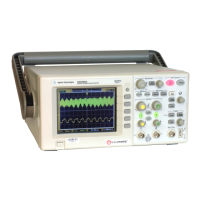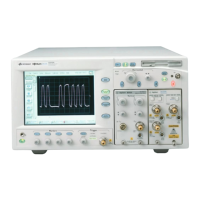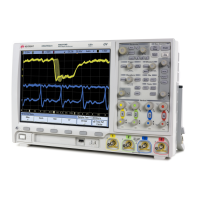962 Agilent InfiniiVision 3000 X-Series Oscilloscopes Programmer's Guide
32 :WAVeform Commands
Data Acquisition Types
There are four types of waveform acquisitions that can be selected for
analog channels with the :ACQuire:TYPE command (see page 239):
NORMal, AVERage, PEAK, and HRESolution. Digital channels are always
acquired using NORMal. When the data is acquired using the :DIGitize
command (see page 199) or :RUN command (see page 219), the data is
placed in the channel buffer of the specified source.
Once you have acquired data with the :DIGitize command, the instrument
is stopped. If the instrument is restarted (via the programming interface
or the front panel), or if any instrument setting is changed, the data
acquired with the :DIGitize command may be overwritten.You should first
acquire the data with the :DIGitize command, then immediately read the
data with the :WAVeform:DATA? query (see page 969) before changing any
instrument setup.
A waveform record consists of either all of the acquired points or a subset
of the acquired points. The number of points acquired may be queried
using :ACQuire:POINts? (see page 232).
Helpful Hints:
The number of points transferred to the computer is controlled using the
:WAVeform:POINts command (see page 972). If :WAVeform:POINts
MAXimum is specified and the instrument is not running (stopped), all of
the points that are displayed are transferred. This can be as many as
4,000,000 in some operating modes or as many as 8,000,000 for a digital
channel on the mixed signal oscilloscope. Fewer points may be specified to
speed data transfers and minimize controller analysis time. The
:WAVeform:POINts may be varied even after data on a channel is acquired.
However, this decimation may result in lost pulses and transitions. The
number of points selected for transfer using :WAVeform:POINts must be an
even divisor of 1,000 or be set to MAXimum. :WAVeform:POINts determines
the increment between time buckets that will be transferred. If POINts =
MAXimum, the data cannot be decimated. For example:
• :WAVeform:POINts 1000 — returns time buckets 0, 1, 2, 3, 4 ,.., 999.
• :WAVeform:POINts 500 — returns time buckets 0, 2, 4, 6, 8 ,.., 998.
• :WAVeform:POINts 250 — returns time buckets 0, 4, 8, 12, 16 ,.., 996.
• :WAVeform:POINts 100 — returns time buckets 0, 10, 20, 30, 40 ,..,
990.
Analog Channel Data
NORMal Data

